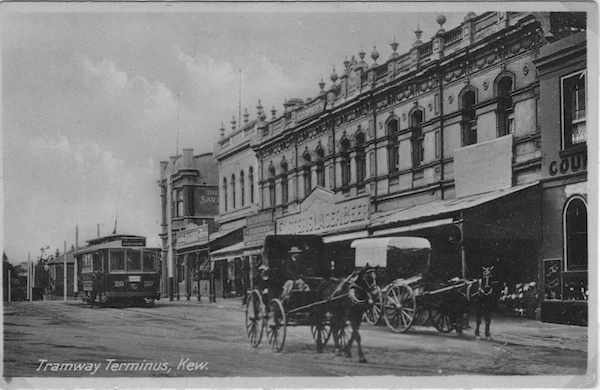Articles by members of the Society about commerce and industry in Kew include:
Clifton Hotel
The Hotel Kew, known for most of its existence, as the Clifton Hotel was built in 1868. Its location on the corner of Studley Park Road and High Street at Kew Junction makes it a prominent landmark.
Read more … Clifton Hotel (PDF, 91 Kb).
Glass’s Creek Pound
While the first successful land sales in Boroondara occurred in Hawthorn in 1843, and Kew in 1845, these areas were to be without local pounds until April 1858, when the Governor of Victoria, in accordance with Act 18 Victoria No 30, was pleased to direct the establishment of a Pound at Glass’s Creek on that part of land bounded by the Kilby Road, Burke Road and High Street.
Read more … Glass’s Creek Pound (PDF, 86Kb).
Greyhound Hotel
The Skinny Dog Hotel, known for most of its existence as the Greyhound Hotel, was built sometime between 1873 and 1874. It is, together with the Hotel Kew (Clifton Hotel) and the Harp of Erin, one of three survivors.
Read more … Greyhound Hotel (PDF, 109 Kb).
Jellis’ Bakeries
In 1947, a fire destroyed the upper storey of Jellis’ Bakeries in Princess Street, Kew. An article in The Argus describes the fire; the number of customers supplied with bread by the bakery (4,000); and lists the Bakeries’ other outlets in Balwyn, North Balwyn and Hawthorn. The Bakery would survive the fire, but as with other locally based enterprises, it was to be swallowed up by a larger conglomerate in the 1960s.
Read more … Jellis Bakeries (PDF, 74 Kb).
Kew Flyer
When it finally closed in 1949, the ‘Kew Flyer’ had been an established business at 8 Cotham Road, opposite the Kew War Memorial, since the turn of the century. Established as a cycle manufacturing business by H. F. Cooper in 1893, it was to move to Brougham Street in 1900 and then to Cotham Road in 1901.
Read more … The Kew Flyer (PDF, 744 Kb).
National Bank of Australasia
The National Bank of Australasia was formed in 1857. It began commercial operations in Queen Street, Melbourne in 1858. Twenty-six years later, in 1885, the Bank’s first bank at 87 High Street opened. A second bank, on the corner of Walpole and Brougham Streets, designed by Inskip & Robertson, replaced the first bank in 1888. The second bank remains, albeit in a somewhat altered state.
Read more … The National Bank of Australasia (PDF, 55Kb).
Princess Hotel
In an inquest into the death of George Bell after a fight in the garden of his home, the aggressor, Charles Hart was apprehended at the Princess Hotel. Sergeant James McGrath of the Kew Police stated that he finally caught up with Hart ‘as he was coming out of the Princess Hotel at Kew’.
Read more … Princess Hotel (PDF, 99 Kb)
Prospect Hill Hotel
The Prospect Hill Hotel was the fourth of nine hotels to be built in Kew. While the building remains, it now operates as a Dan Murphy liquor license outlet. Built in 1858 at one of the higher points in the suburb, on the corner of Bulleen Road (now High Street) and Little Derby Street (now Cobden Street), for many years the hotel and the surrounding businesses formed a separate business centre from the rest of Kew.
Read more … Prospect Hill Hotel (PDF, 99 Kb).
Woodman Inn
The first mention of ‘The Woodman’ occurred in March 1854, when Joseph Willoughby of Prahran applied to the Licensing Board for an application to open a hotel in Kew. His application was to be refused by the bench until the next licensing day.
Read more …Woodman Inn (PDF, 96 Kb).
